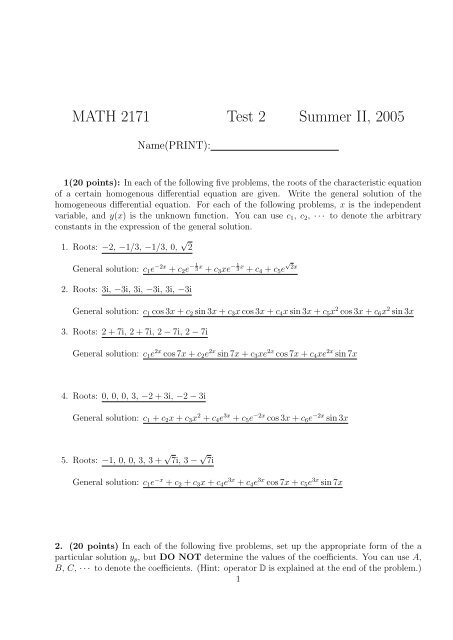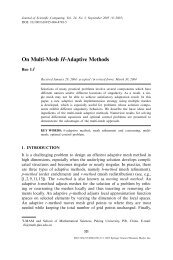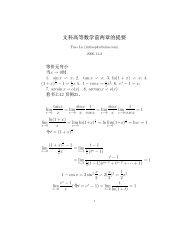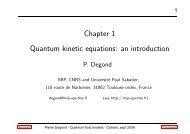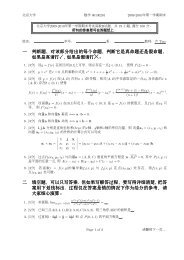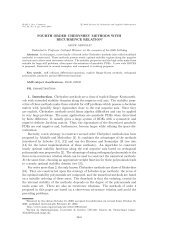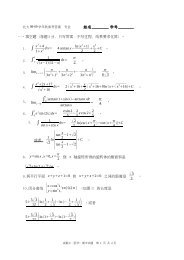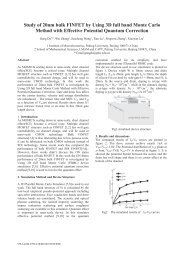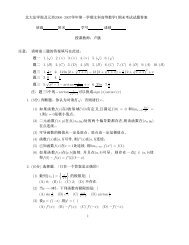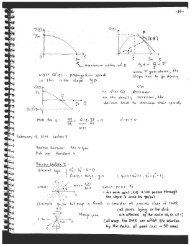You can download: Key to the second test
You can download: Key to the second test
You can download: Key to the second test
Create successful ePaper yourself
Turn your PDF publications into a flip-book with our unique Google optimized e-Paper software.
MATH 2171 Test 2 Summer II, 2005<br />
Name(PRINT):<br />
1(20 points): In each of <strong>the</strong> following five problems, <strong>the</strong> roots of <strong>the</strong> characteristic equation<br />
of a certain homogenous differential equation are given. Write <strong>the</strong> general solution of <strong>the</strong><br />
homogeneous differential equation. For each of <strong>the</strong> following problems, x is <strong>the</strong> independent<br />
variable, and y(x) is <strong>the</strong> unknown function. <strong>You</strong> <strong>can</strong> use c1, c2, · · · <strong>to</strong> denote <strong>the</strong> arbitrary<br />
constants in <strong>the</strong> expression of <strong>the</strong> general solution.<br />
1. Roots: −2, −1/3, −1/3, 0, √ 2<br />
General solution: c1e−2x 1<br />
− + c2e 3 x 1<br />
− + c3xe 3 x + c4 + c5e √ 2x<br />
2. Roots: 3i, −3i, 3i, −3i, 3i, −3i<br />
General solution: c1 cos 3x + c2 sin 3x + c3x cos 3x + c4x sin 3x + c5x 2 cos 3x + c6x 2 sin 3x<br />
3. Roots: 2 + 7i, 2 + 7i, 2 − 7i, 2 − 7i<br />
General solution: c1e 2x cos 7x + c2e 2x sin 7x + c3xe 2x cos 7x + c4xe 2x sin 7x<br />
4. Roots: 0, 0, 0, 3, −2 + 3i, −2 − 3i<br />
General solution: c1 + c2x + c3x 2 + c4e 3x + c5e −2x cos 3x + c6e −2x sin 3x<br />
5. Roots: −1, 0, 0, 3, 3 + √ 7i, 3 − √ 7i<br />
General solution: c1e −x + c2 + c3x + c4e 3x + c4e 3x cos 7x + c5e 3x sin 7x<br />
2. (20 points) In each of <strong>the</strong> following five problems, set up <strong>the</strong> appropriate form of <strong>the</strong> a<br />
particular solution yp, but DO NOT determine <strong>the</strong> values of <strong>the</strong> coefficients. <strong>You</strong> <strong>can</strong> use A,<br />
B, C, · · · <strong>to</strong> denote <strong>the</strong> coefficients. (Hint: opera<strong>to</strong>r D is explained at <strong>the</strong> end of <strong>the</strong> problem.)<br />
1
1. (D + 2)(D + 1)y = e 2x + 3e 3x + x 2 e x<br />
yp = Ae 2x + Be 3x + (C + Dx + Ex 2 )e x<br />
2. (D + 2)(D + 1)y = sin 2x + sin 3x<br />
yp = A cos 2x + B sin 2x + C cos 3x + D sin 3x<br />
3. D 2 (D + 2)(D + 1)y = 3x 2 + cos(3x)<br />
yp = x 2 (A + Bx + Cx 2 ) + D cos 3x + E sin 3x<br />
4. (D 2 + 4)y = x sin 2x + e x<br />
yp = x[(A + Bx) cos 2x + (C + Dx) sin 2x] + Ee x<br />
5. (D + 2)(D + 1)y = e 2x cos(2x)<br />
yp = Ae 2x cos 2x + Be 2x sin 2x<br />
(Hint: In this problem, we suppose that y(x) is <strong>the</strong> unknown function and x is <strong>the</strong> independent<br />
variable. D is an opera<strong>to</strong>r denoting <strong>the</strong> opertion of differentiation with respect <strong>to</strong> x, so that<br />
Dy = dy<br />
dx<br />
We know it is easy <strong>to</strong> get <strong>the</strong> characteristic equation for differential equations written by using<br />
<strong>the</strong> opera<strong>to</strong>r D, e.g. <strong>the</strong> characteristic equation of<br />
is<br />
= y′<br />
(D − 2) 2 (D + 3)y = 0<br />
(r − 2) 2 (r + 3) = 0).<br />
2
3(15 points): Solve <strong>the</strong> following initial value problem (x is <strong>the</strong> independent variable):<br />
Solution: The characteristic equation is<br />
y ′′ + 4y = 8x 2 ; y(0) = 1, y ′ (0) = 0.<br />
r 2 + 4 = 0<br />
and its roots are ±2i. So <strong>the</strong> complementary function is<br />
yc = c1 cos 2x + c2 sin 2x<br />
The first guess of a particular solution is of <strong>the</strong> form<br />
yp = A + Bx + Cx 2<br />
according <strong>to</strong> <strong>the</strong> right hand of <strong>the</strong> nonhomogeneous equation. Compare yc and yp and we find<br />
<strong>the</strong>re is no duplication. So <strong>the</strong> appropriate form of a particular solution is<br />
yp = A + Bx + Cx 2<br />
Substitution yp and its derivatives in<strong>to</strong> <strong>the</strong> nonhomogeneous equation yields<br />
2C + 4(A + Bx + Cx 2 ) = 8x 2<br />
Collecting coefficients and equating <strong>the</strong> coefficients of like terms yield<br />
2C + 4A = 0; 4B = 0; 4C = 8<br />
So A = −1, B = 0, C = 2. So <strong>the</strong> general solution of <strong>the</strong> nonhomogeneous equation is<br />
y = c1 cos 2x + c2 sin 2x + (−1 + 2x 2 )<br />
The initial conditions y(0) = 1 and y ′ (0) = 0 yield<br />
1 = c1 cos(2 · 0) + c2 sin(2 · 0) + (−1 + 2 · 0 2 )<br />
0 = −2c1 sin(2 · 0) + 2c2 cos(2 · 0) + 4 · 0<br />
So c1 = 2, c2 = 0. Plugging c1 and c2 in<strong>to</strong> <strong>the</strong> general solution yields <strong>the</strong> solution of <strong>the</strong><br />
initial value problem<br />
y = −1 + 2x 2 + 2 cos 2x<br />
3
4. (15 points) Use <strong>the</strong> method of variation of parameters <strong>to</strong> find a particular solution of<br />
<strong>the</strong> given differential equation (x is <strong>the</strong> independent variable)<br />
y ′′ − 2y ′ + 2y = e x sec x.<br />
Solution: The characteristic equation r 2 − 2r + 2 = 0 has roots 1±i. So <strong>the</strong> complementary<br />
function is<br />
yc = c1e x cos x + c2e x sin x<br />
. The Wronskian is<br />
So we get a particular solution<br />
y1 = e x cos x, y2 = e x sin x<br />
<br />
<br />
W (x) = <br />
y1(x)<br />
<br />
y2(x) <br />
<br />
= e2x<br />
u ′ 1(x) = − y2(x)e x sec x<br />
W (x)<br />
u ′ 2(x) = y1(x)e x sec x<br />
y ′ 1(x) y ′ 2(x)<br />
= − ex sin x sec x<br />
e x<br />
= − tan x<br />
W (x)<br />
= − ex cos x sec x<br />
ex <br />
= 1<br />
u1(x) = − tan xdx = ln | cos x|<br />
<br />
u2(x) =<br />
1dx = x<br />
y = u1(x)y1(x) + u2(x)y2(x) = ln | cos x|e x cos x + xe x sin x<br />
4
5.(10 points): Transform <strong>the</strong> given equation (t is <strong>the</strong> independent variable) in<strong>to</strong> an equivalent<br />
system of first-order differential equations.<br />
x (4) = 3x (3) + 5x ′′ + 3x + cos 4t.<br />
Solution: Let x1 = x, x2 = x ′ , x3 = x ′′ , x4 = x (3) .<br />
Equivalent system:<br />
x ′ 1 = x2<br />
x ′ 2 = x3<br />
x ′ 3 = x4<br />
x ′ 4 = 3x4 + 5x3 + 3x1 + cos 4t<br />
5
6.(15 points) Find general solutions of <strong>the</strong> given linear system (t is <strong>the</strong> independent variable)<br />
by using <strong>the</strong> method of elimination.<br />
Solution:<br />
From Eq. (1), we have<br />
and<br />
x ′ = 2x + y, y ′ = x + 2y − e 2t<br />
x ′ = 2x + y (1)<br />
y ′ = x + 2y − e 2t<br />
(2)<br />
y = x ′ − 2x (3)<br />
y ′ = x ′′ − 2x ′<br />
Plugging Eq. (3) and Eq. (4) in<strong>to</strong> Eq. (2) yields<br />
which is simplified in<strong>to</strong><br />
x ′′ − 2x ′ = x + 2(x ′ − 2x) − e 2t<br />
x ′′ − 4x ′ + 3x = −e 2t<br />
The characteristic equation of Eq. (5) r2 − 4r + 4 = 0 has roots 1 and 3. So <strong>the</strong> complementary<br />
function of Eq. (5) is<br />
xc = c1e t + c2e 3t<br />
(6)<br />
First guess of <strong>the</strong> form of a particular solution is<br />
xtrial = Ae 2t<br />
Comparing xc and xtrial, we find <strong>the</strong>re is no duplication and get <strong>the</strong> appropriate form of a<br />
particular solution<br />
Plugging Eq. (8 in<strong>to</strong> Eq. (5) yields<br />
xp = Ae 2t<br />
4Ae 2t − 4 · (2Ae 2t ) + 3Ae 2t = −e 2t<br />
which gives A = 1. We plug A = 1 in<strong>to</strong> Eq. (8) and get a particular solution<br />
So <strong>the</strong> general solution for x is<br />
And we <strong>can</strong> get from Eq. (10)<br />
xp = e 2t<br />
x = c1e t + c2e 3t + e 2t<br />
x ′ = c1e t + 3c2te 3t + 2e 2t<br />
Plugging Eqs. (refeq10) and (11) in<strong>to</strong> Eq. (3) yields <strong>the</strong> general solution for y<br />
y = −c1e t + c2e 3t<br />
So <strong>the</strong> general solution of <strong>the</strong> system is (10) and (12).<br />
6<br />
(4)<br />
(5)<br />
(7)<br />
(8)<br />
(9)<br />
(10)<br />
(11)<br />
(12)
7.(5 points) Use <strong>the</strong> Wronskian <strong>to</strong> prove <strong>the</strong> <strong>the</strong> functions<br />
f(x) = e x , g(x) = e 2x , h(x) = e 3x<br />
are linearly independent on <strong>the</strong> real line.<br />
Solution: Wronskian of <strong>the</strong> three functions is<br />
<br />
<br />
<br />
W (f(x), g(x), h(x)) = <br />
<br />
<br />
= e (x+2x+3x)<br />
<br />
<br />
<br />
<br />
<br />
<br />
= e 6x<br />
<br />
<br />
1 1 1<br />
<br />
0 1 2<br />
0 3 8<br />
= e 6x<br />
<br />
<br />
1 1 1<br />
<br />
0 1 2<br />
0 0 2<br />
ex e2x e3x ex 2e2x 3e3x ex 4e2x 9e3x <br />
<br />
<br />
<br />
<br />
<br />
<br />
<br />
<br />
<br />
<br />
<br />
<br />
<br />
<br />
<br />
<br />
<br />
<br />
<br />
<br />
<br />
<br />
= 2e6x = 0<br />
1 1 1<br />
1 2 3<br />
1 4 9<br />
So <strong>the</strong> three functions are linearly independent on <strong>the</strong> real line.<br />
7


